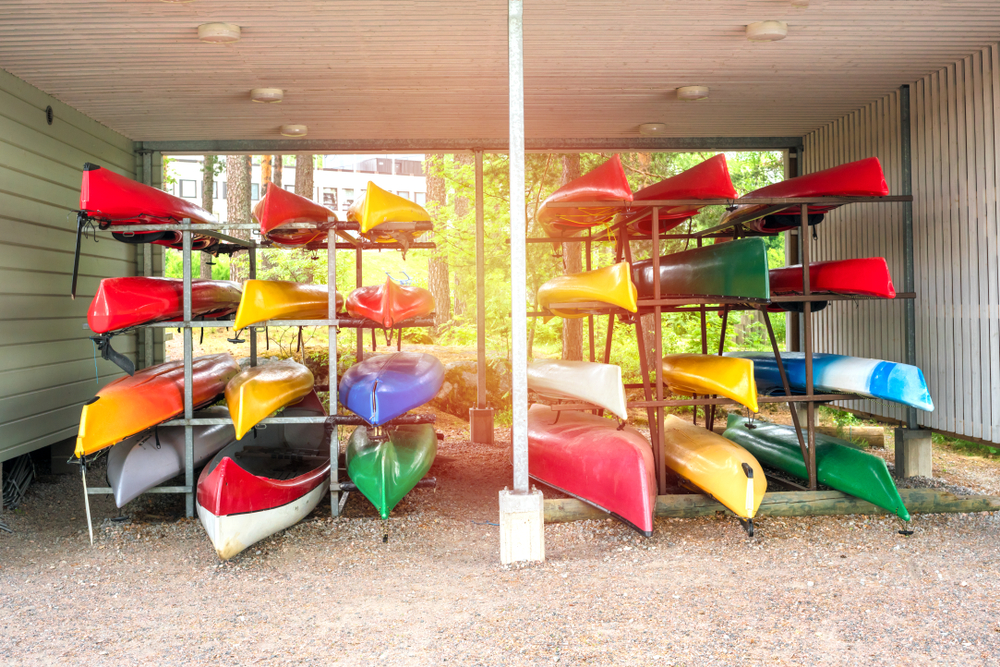Whether you’re a lake-goer or a beach bum, jet skis deliver countless hours of fun in the sun. But when your personal watercraft (PWC) isn’t in the water, what do you do with it?
For some, there’s no choice but to park them on a trailer behind the garage, which is both unsightly for your neighbors and hazardous for your jet ski.
Not to mention, unless you have trailer locks or similar security measures, you risk having your PWC stolen from your backyard!
However, not everyone has a garage or an enclosed storage structure, such as a shed.
Whether you just don’t have room in your garage, lack shed storage, or you can’t afford a marina storage spot, self-storage can be the perfect solution to your jet ski storage woes.
This guide will cover the importance of jet ski storage, what can go wrong, and how to prep your jet ski for storage.
We’ll review the personal watercraft storage options out there so that you can make an informed decision on where to store your jet ski all year long or just off-season.
And finally, we’ll reveal how Storage.com can help you find jet ski storage near you.
Why Jet Ski Storage Matters
Where you store your jet ski matters because not all neighborhood HOAs allow you to store your jet ski in your yard. Improper jet ski storage can cause fuel degradation that can corrode your fuel tank and fuel lines.
Failing to drain your jet ski’s fluids before long-term offseason storage can also lead to engine corrosion. And if you don’t hook your water scooter’s battery up to a battery maintainer, you’ll come back to a dead battery once the sun’s back out.
We’ve listed some general guidance on how to store your jet ski below. Always check your owner’s manual before starting. If anything in your owner’s manual contradicts our basic default storage tips, always go with the manual’s instructions first and foremost!
How to prep your personal watercraft for storage: the jet ski storage process
Want the full checklist?
- Wash hull and deck with mild, non-abrasive cleaner
- Clean your jet pump and intake grate with a small brush
- Flush your cooling system with a fresh water flush kit
- Inspect the hull for cracks or scratches
- Check handlebars, seat, and other components for wear
- Add fuel stabilizer to the tank to reduce fuel degradation, which can cause clogs in your air-fuel system
- Run the engine for a few minutes to circulate the treated fuel
- Fill the fuel tank to reduce condensation and moisture buildup in the tank, which can cause rust and corrosion in the tank and fuel lines
- Disconnect your jet ski’s battery (negative terminal first, then positive)
- Store battery in a cool, dry place connected to a battery maintainer or battery tender, and inspect your battery’s voltage and condition every 30-60 days during storage
- Apply marine-grade lubricant to moving parts, steering, and throttle cables
- Spray fogging oil into the engine cylinders
- Store your PWC indoors in a dry, temperature-controlled storage space if possible
- Use a durable, breathable all-weather cover for protection
- Check trailer tires for proper inflation
- Inspect trailer bearings and grease as needed
- Remove electronics, riding gear, and personal belongings
- Attach your watercraft to your trailer using trailer locks, cable locks, or U-locks for added security.
- Update your service records and maintenance log after changing the fluids
- Review your personal watercraft’s insurance and registration policies
Indoor vs. Outdoor Jet Ski Storage

When it comes to long-term jet ski storage, indoor storage is the best option, no matter where you live. Sun is horrible on paint, seats, and traction mats, while freezing temperatures can wreak havoc on the ski jet engine.
Indoor jet ski storage options include indoor dry stack storage, renting a self-storage unit, or storing your water scooter at home in a shed or garage. An affordable and widely available option is to store your watercraft outdoors, either in a marina or in outdoor dry stack storage.
No matter what option you go for, whenever your PWC is not in use, it ought to be covered or indoors to protect it from UV rays, bird droppings, or anything else.
And, if you don’t live in a warmer climate, direct sunlight can cause UV damage to your uncovered jet ski, so you should also pay extra attention to jet ski winterization before storing it.
Jet ski covers
Wherever you store your jet ski and no matter the temperature, you should use a high-quality, all-weather cover. All-weather covers protect your PWC from grime build-up, pests, and the elements during long-term off-season storage periods.
- Look for durable, waterproof jet ski covers made from polyester or marine-grade canvas.
- Get a good fit. If the cover is too tight, you risk damage to your personal watercraft; too loose, it won’t offer full protection. Can’t find a cover designed for your jet ski model? Get an adjustable one with straps.
- Your cover should be easy to put on and take off, encouraging regular use. Look for features like elastic hems, quick-release buckles, or zippers that make the process more straightforward.
Indoor Dry Stack Storage for Jet Skis
Coastal cities have what’s called a dry stack storage facility. Dry stack storage is a warehouse where boats and jet skis are stacked on giant shelves. It’s as simple as dropping off your watercraft at the dry stack storage facility. From there, the storage provider does the heavy lifting… literally.
Beyond the obvious protection from sun, rain, and snow, indoor dry stack storage facilities often maintain a controlled environment to further protect your personal watercraft from humidity and salt air, which helps prevent fuel tank rust and engine corrosion.
Some dry stack storage customer service plans include on-site jet ski maintenance services, ranging from basic engine checks to comprehensive servicing and winterization processes.
It might seem like a premium option, but preserving the life of your water scooter with routine maintenance is quite cost-effective in the long run.
Rent a Storage Unit for Your Jet Ski
A dry stack storage facility isn’t an option in every region. For the rest of us, our best bet is a climate-controlled indoor storage unit at a self-storage facility. Here’s what you need to know about keeping your water scooter there:
- It’s important to find the right size unit for your jet ski and trailer, with a little extra space to move around them.
- A 10’x10’ or a 5’×15’ unit size may be enough for a smaller PWC trailer.
- A 10’×15’ unit size is big enough to fit the jet ski and its trailer, yet small enough that space isn’t wasted. Plus, you’ll have some room for fuel containers, tool boxes, and to circle the PWC and trailer to conduct off-season maintenance.
- You’ll need to store your jet ski at a ground-level storage unit, as you won’t be able to get your PWC – and its trailer – up to a second or third-story unit without an industrial forklift.
- Drive-up storage units are outdoor units where you park directly in front for easy loading.
- Drive-up storage unit access lets you back your trailer up, making loading and unloading your jet ski a breeze, but its harder to find a drive-up unit with climate control.
- First-floor storage units are indoor units with climate control and more advanced security features. Indoor first-floor costs more but offers climate-control to help protect your watercraft during the off season.
There are other amenities besides security features and temperature control to consider. Electrical outlets are nice to have so you can use a trickle charger. You can also use an electric pump to inflate the tires on your jet ski trailer when it is time to hit the water.
Jet skis are expensive, so you’ll want to snag PWC storage at a secure facility. Look for properties with a fence, gated access and video surveillance.
Climate-controlled jet ski storage is a plus and, in some areas, a must.
Jet Ski Storage Solutions at Home
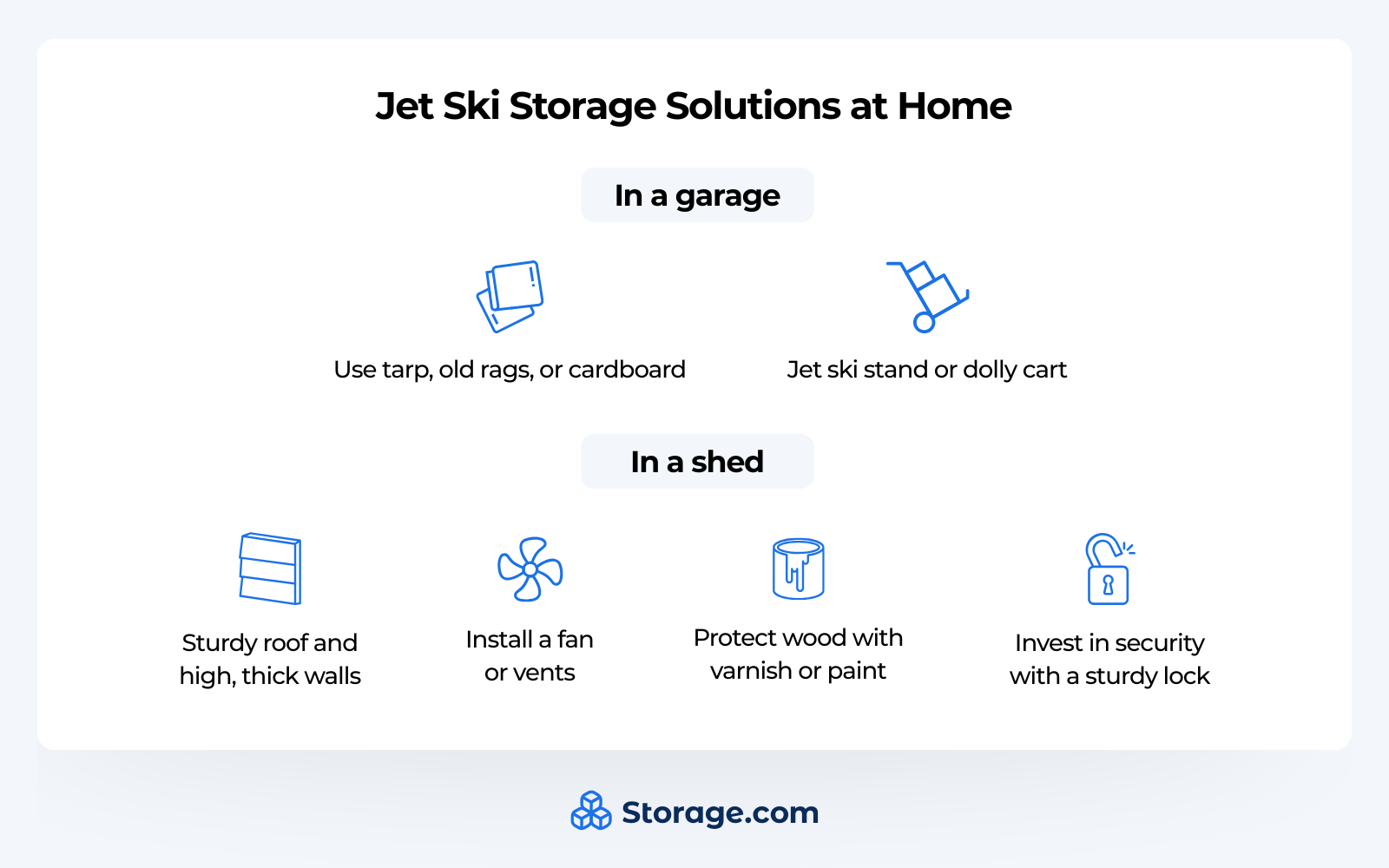
Storing your jet ski at home gives you easy access and control over its condition. Plus, you could store it in your backyard or driveway for free.
However, many neighborhoods have rules against outdoor vehicle storage, and we’ve already discussed how indoor is easier on your watercraft’s lifespan. In this case, you have two main options: shed storage or garage storage. Let’s explore both.
Jet ski storage in the garage
Before you get too excited about saving money on storage by putting your PWC in the garage, first check that you have enough space. A jet ski and its trailer can take up as much valuable space as a four-passenger car.
- Lay down a tarp, old rags, or cardboard in the jet ski storage area to protect your garage floor from scratches and oil leaks.
- A jet ski stand or dolly cart can save space and make maintenance tasks easier, especially in tight spaces.
Jet ski storage shed
If you’re in a townhouse or part of a Homeowners Association, check any rules regarding outdoor sheds before you build or adapt an existing one to be big enough for your jet ski and its trailer.
- A good jet ski storage shed protects against wind, rain, and sun — this means a sturdy roof and high, thick walls.
- Keep the air moving by installing a fan or vents to prevent moisture buildup.
- Is the shed floor made of wood? Protect it with varnish or paint.
- Last, but not least, invest in security with a sturdy lock on the shed door.
Marina Jet Ski Storage
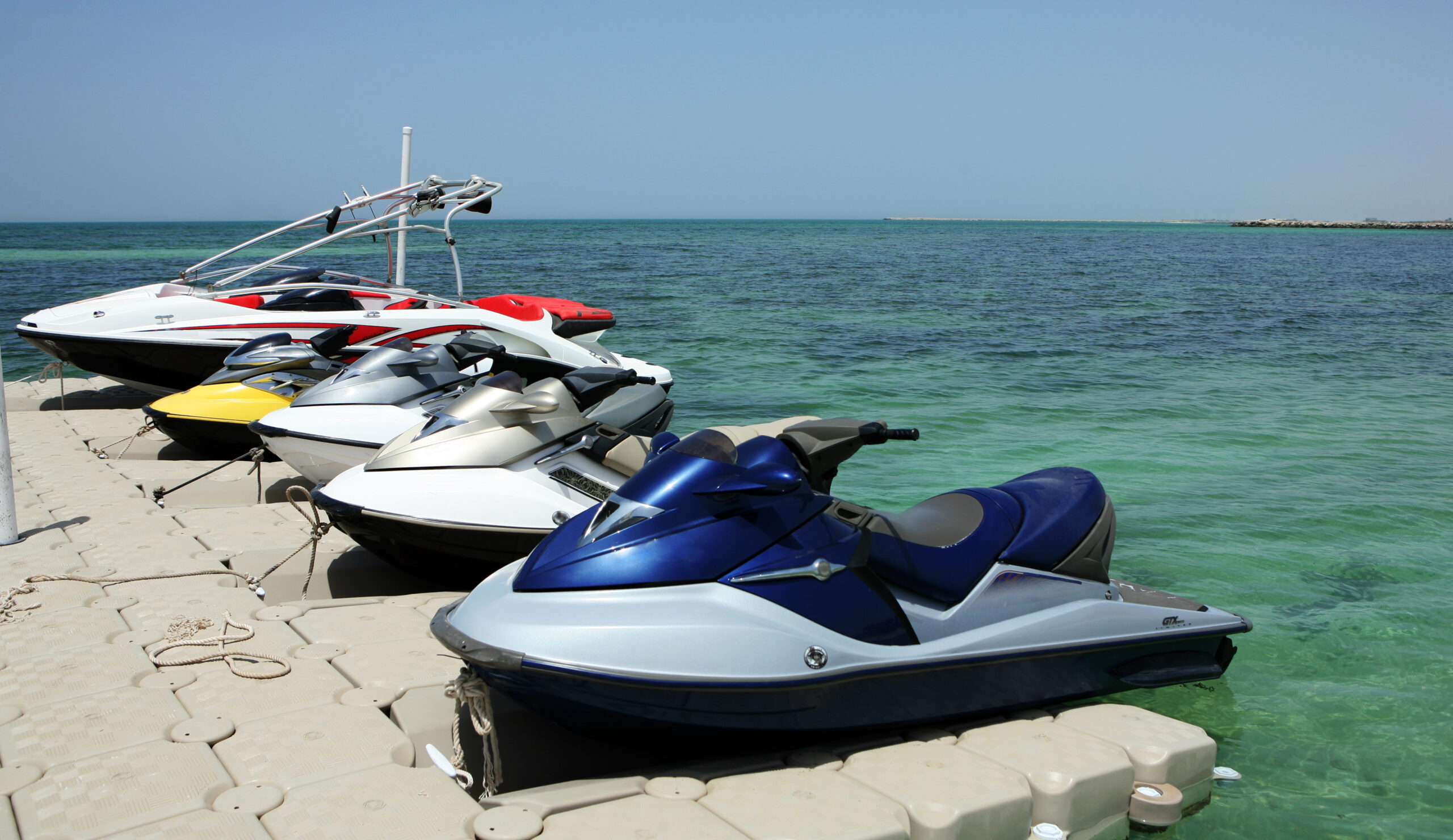
Keeping your jet ski at a marina doesn’t mean leaving it in water attached to a floating dock. Even if it’s freshwater, it can still damage your watercraft if you leave it in for more than a few days. That’s why many marinas and boat storage lots offer dry-stack storage — no towing, no hassle, just show up and hit the water. Talk about easy.
Sure, we’ve already covered the indoor version, but there’s also an outdoor dry rack — this is a solid pick if you’re watching your budget but still want your jet ski taken care of, especially if you live in an area without harsh temperatures.
Fancy a ride? Just call ahead. The marina staff uses a special forklift to get your jet ski into the water. It’s a bit like valet parking but for the sea. Then, when you’re done, you just hand it back to the marina staff.
Other options at the marina are floating jet ski dock storage or renting a floating slip. Since jet skis are small, the cost will most likely be about half what you’d pay for most size boats.
The floating docks are in a no-wake zone, and they usually include access to showers and dockside electric supply.
That said, keeping your jet ski in the water attached to a floating dock leaves it exposed to harsh weather. And even if the climate is temperate, keeping the watercraft in the water for long-term off-season storage will shorten its life.
Pro Tip: Before opting for marina jet ski storage in a dry stack, ask about additional costs for extra services, how many launches you get (typically, a free one every day), and how they handle busy days like summer weekends.
How Storage.com can Help Find the Best Watercraft Storage Solutions Near You
So, we’ve zipped through a bunch of ways to keep your jet ski safe when you’re not making waves. From tucking it into a cozy indoor spot to letting it chill at a marina, there’s a fit for every jet ski and every budget.
Got a garage with some room to spare? Perfect as long as no car has to suffer. Thinking about a jet ski storage shed? Check with your HOA first, and definitely insulate it.
The primary drawback to storing your PWC in your garage or shed is how much space it takes up, especially during the off-season, when it sits in long-term storage without moving for months on end.
Storage sheds may not be able to hold your trailer, even if you can squeeze in your jet ski. Your trailer tires can deflate or even rot if you store the trailer out in the elements for months on end. And that’s if your neighborhood HOA doesn’t have a policy against it.
But even if you do have a garage or shed storage space to spare, is it climate-controlled?
A climate-controlled storage unit includes temperature control and humidity monitoring, and management. Storage units also offer features like electricity, alarms, 24-hour access, drive-up access, or security cameras for added watercraft protection. And again, you’ll need a ground-level storage unit.
But not all storage facilities offer the same amenities.
So, how do you find the perfect jet ski storage facility? How do you limit your search results to drive-up storage units? Or maybe you want to search by location, isolating storage facilities that are halfway between your house and your favorite wave-ripping ocean or lake spot.
Good news, thanks to storage.com, you don’t have to choose.
Enter your zip code into our storage.com boat storage search feature to find the best deal on a dedicated water vehicle storage space near you.
Check the watercraft storage sizes the facility has available, and look for something that gives you ample space for both your PWC and you to move around it. Consider whether or not you’re only storing your jet ski, or if you’ll also be storing additional items alongside your watercraft.
We also suggest establishing which amenities you need before you start shopping for jet ski storage. Browse the options based on your area and look for offerings like long-term storage, short-term storage, climate-controlled indoor spaces, covered spaces, etc.
Storage.com gives you access to the largest marketplace for storage facilities of all types, and our storage search tool makes finding storage units big enough for a jet ski and trailer as easy as entering your zip code, filtering the options, and scrolling the results until you find exactly what you need.
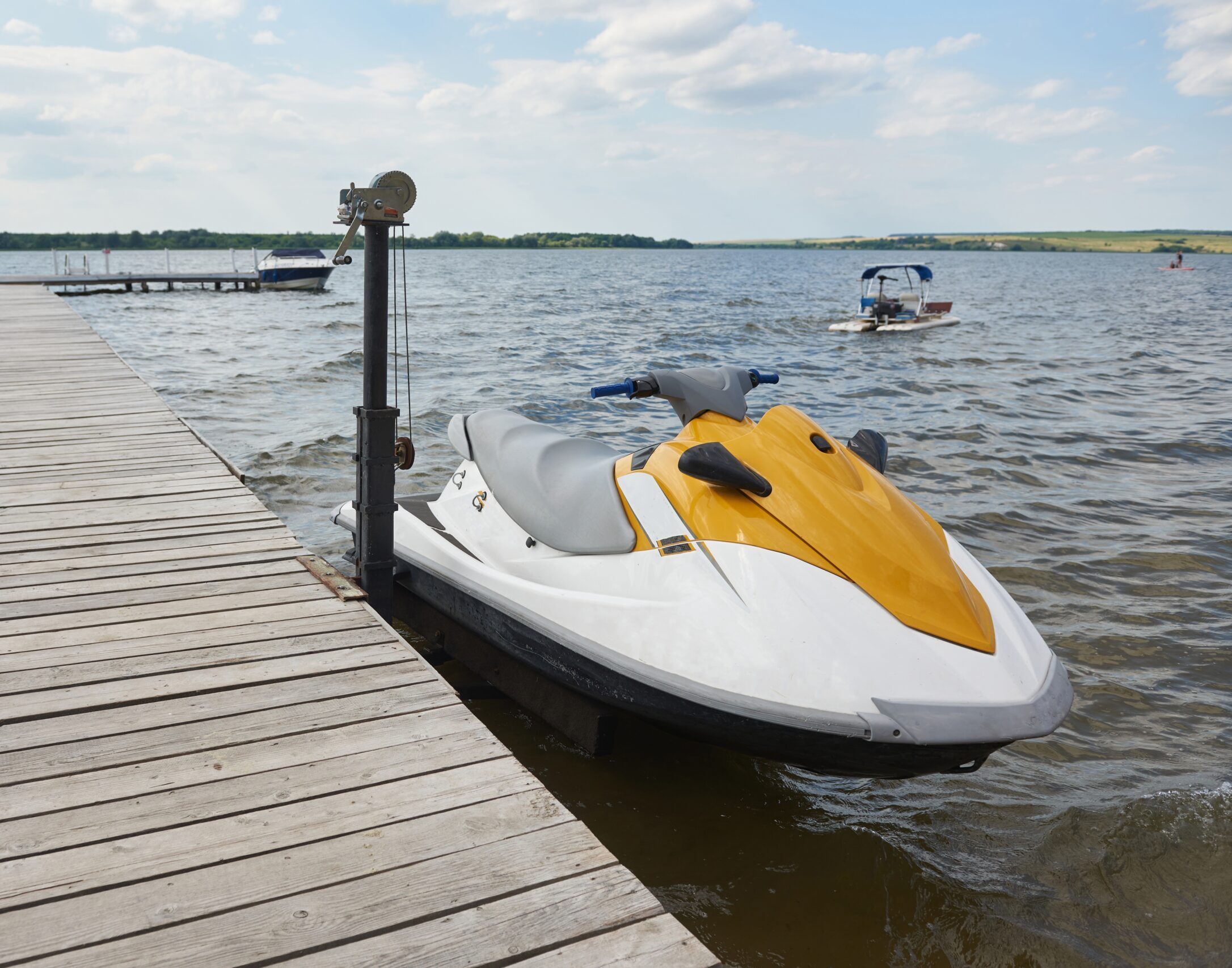





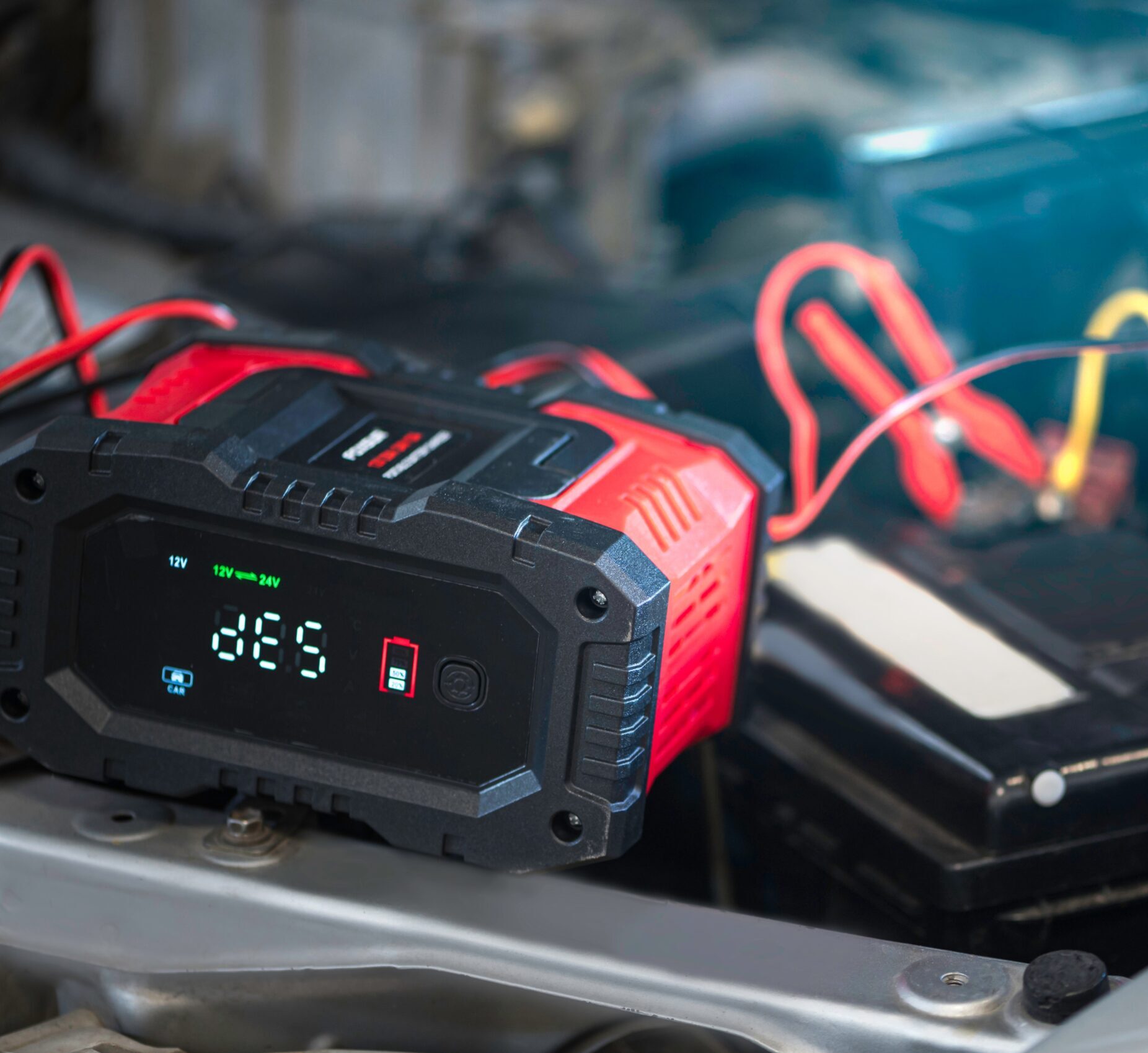

![Relocating RVs: An Expert Guide to Finding RV Relocation Deals and Cheap Motorhomes for Rent [2025]](https://blog.storage.com/wp-content/uploads/2025/03/rv-relo.jpg)
